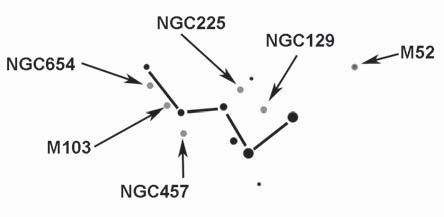2014 March 28
The sky in April & May
| First Quarter | Full | Last Quarter | New |
| Apr 7 | Apr 15 | Apr 22 | Apr 29 |
| May 7 | May 14 | May 21 | May 28 |
In the north Ursa Major is close to the zenith with his smaller namesake pointing vertically towards him, whilst the head of Draco looks eastward towards neighbouring Hercules. The familiar ‘W’ of Cassiopeia lies on the meridian below the celestial pole with her collection of open clusters. These include NGCs 654, 457, 129 and 225, plus M103 and M52 which are Charles Messier’s contribution to the area’s cluster tally. Nearby Camelopardalis also contains one such moderately bright amalgamation of stars in NGC 1502 at magnitude 5.7. The double cluster in the sword handle of Perseus is at an altitude of 20° and still a fine sight in binoculars.
 As we look east the bright star Vega, in Lyra, is making its presence felt, although of its two fainter companions in the Summer Triangle, only Deneb is currently above the horizon. The faint summer constellations of Hercules, Corona Borealis and Ophiuchus are all now visible and are in stark contrast to the winter groups that have now vacated the evening skies for another year.
As we look east the bright star Vega, in Lyra, is making its presence felt, although of its two fainter companions in the Summer Triangle, only Deneb is currently above the horizon. The faint summer constellations of Hercules, Corona Borealis and Ophiuchus are all now visible and are in stark contrast to the winter groups that have now vacated the evening skies for another year.
Towards the south the faint constellations of Canes Venatici and Coma Berenices are high on the meridian whilst below them lies Virgo which contains a large number of faint galaxies. A little lower than Virgo, and on the meridian, is the southern end of the sprawling line of stars that make up Hydra. Corvus (the crow) and Crater (the cup) appear to be riding on the back of the celestial sea serpent. Delta Corvi is a telescopic double with a yellow primary (mag 3.0) and a pale blue secondary (mag 8.5) that have a 24 arcsecond separation.
In the west the Hunter and his entourage have gone although Gemini and Auriga remain, whilst Cancer with the lovely open cluster M44 is at a respectable 35° altitude. Leo will be on view for some time to come so take a look at the double star gamma Leonis, at the base of the Lion’s neck. A small aperture is all that is required to see this pair with magnitudes of 2.4 and 3.6 that lie 4.3″ apart.
Planets and dwarf planets
In the dawn sky, Mercury is very poorly placed for observation from the UK during April due to the acute angle that the ecliptic makes with the horizon in the early mornings at this time of year. However, superior conjunction occurs on April 26, after which observers in northern temperate latitudes are rewarded with an excellent evening apparition with the planet reaching greatest eastern elongation on May 25. On that night with the Sun 6° below the horizon, Mercury is 10° high in the west-north-west at magnitude +0.4.
Venus is still a brilliant morning object although its period of visibility is becoming very gradually shorter for observers in the UK. At the beginning of April the planet rises 11⁄2 hours ahead of the Sun with the two bodies having an angular separation of 46°. By the end of May this has shrunk to 37°. Venus has close encounters with both of the ice giants during the period, passing around 40′ from Neptune on April 12 and a little over a degree from Uranus on May 16. The phase of the planet is increasing whilst its brightness and apparent diameter are both decreasing.
Mars reaches opposition on April 8 and culminates at an altitude of almost 34°. It spends the whole period at a maximum magnitude of -1.5 in Virgo, where it travels retrograde until May 20 when it reaches its second stationary point. Thereafter it moves direct, not arriving in neighbouring Libra until early August.
Jupiter, in the constellation Gemini, sets at 03:00 as the period in question begins, but by the end it has moved closer to the Sun and sets just three hours after our parent star. Its brightness and apparent diameter are both dwindling as it heads towards opposition in July. A waxing crescent Moon is nearby on May 4.
Saturn rises well before midnight at the start of April in preparation for opposition on May 10. It moves retrograde in Libra for the whole of the period, brightening very slightly to +0.1 as it does so. The angle of the planet’s pole means the rings are still well presented towards the Earth, though this does drop very slightly before picking up again later in the year to reach more than 24°.
Uranus is in opposition on April 2 after which it moves west of the Sun to become a morning object in Pisces, where it spends the remainder of the year. At magnitude +5.9 it is at the limit of naked eye visibility for most people.
Neptune is a mag +8.0 object in Aquarius, rising an hour before the Sun at the start of April. At the end of the period it rises just before 01:00 UT.
(1) Ceres and (4) Vesta both spend April and May in Virgo approximately 1.5° apart, rising at 19:15 UT at the start of this period.
| The British Astronomical Association supports amateur astronomers around the UK and the rest of the world. Find out more about the BAA or join us. |
